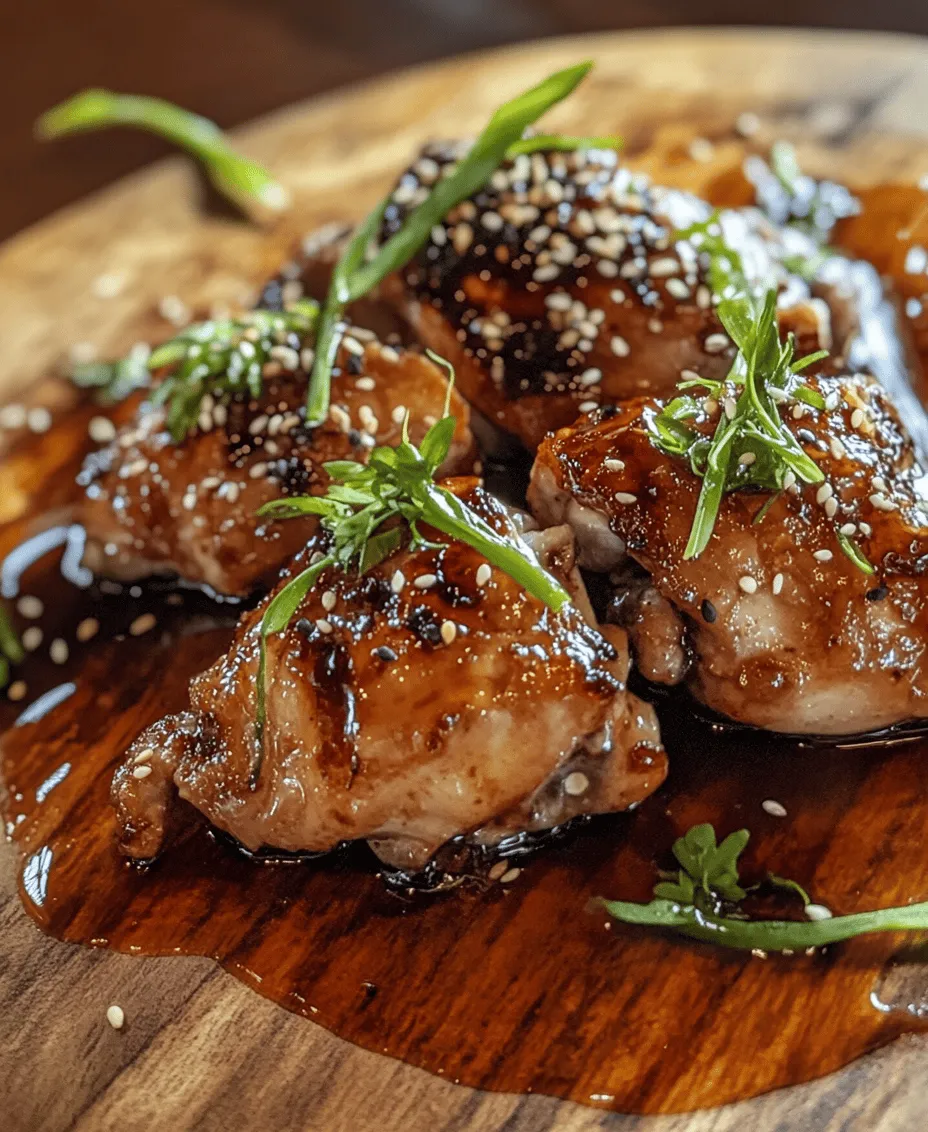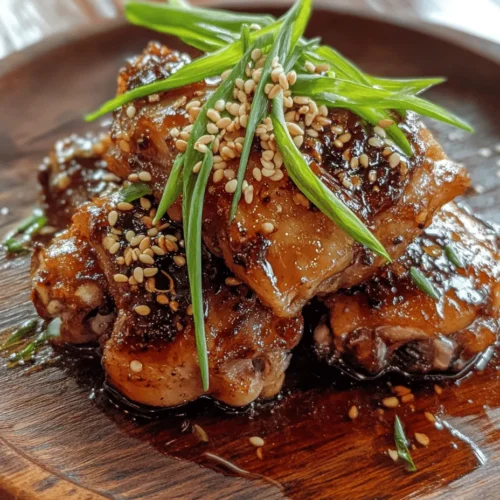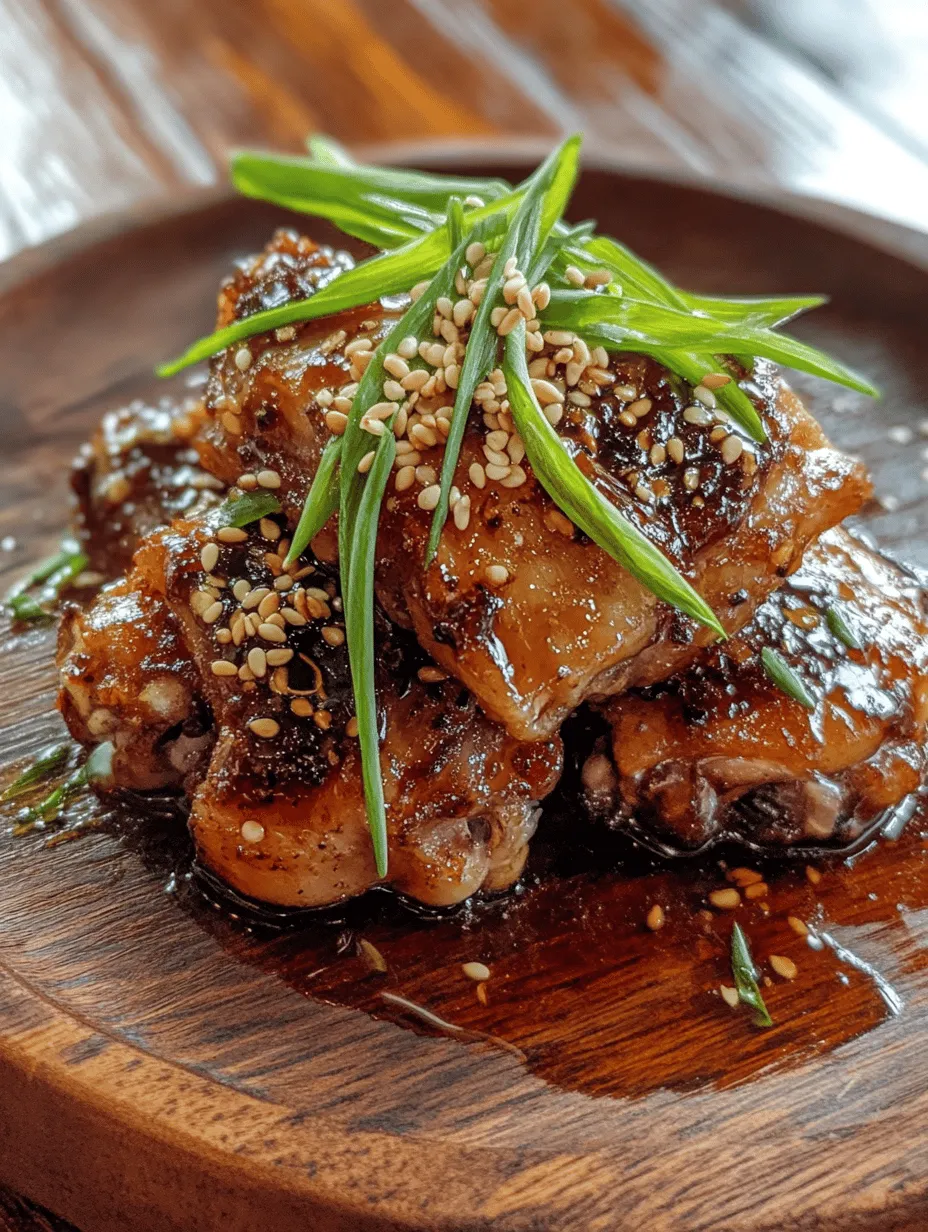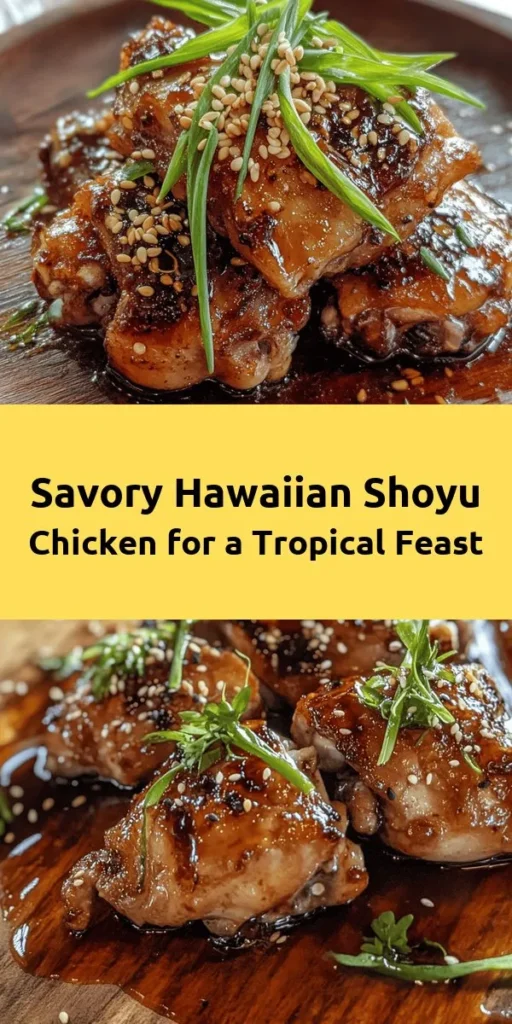Introduction
Hawaiian Shoyu Chicken is a beloved dish that encapsulates the essence of Hawaii’s culinary landscape, blending savory, sweet, and tangy flavors into a harmonious meal that is perfect for family dinners or special occasions. This dish has gained popularity not only among locals but also among visitors who seek to experience the unique tastes of Hawaiian cuisine. With its roots deeply embedded in the cultural exchange between Hawaiian and Japanese culinary traditions, Hawaiian Shoyu Chicken offers a delicious glimpse into the islands’ diverse food heritage.
This dish is characterized by its succulent chicken pieces marinated in a flavorful blend of soy sauce and other ingredients that make it stand out. The secret lies in the thoughtful combination of flavors and the marination process, which transforms ordinary chicken into a dish bursting with personality and depth. Whether you’re planning a casual family gathering or a festive celebration, Hawaiian Shoyu Chicken is sure to impress your guests and tantalize their taste buds.
The Origins of Hawaiian Shoyu Chicken
To truly appreciate Hawaiian Shoyu Chicken, it helps to understand its origins and cultural significance in Hawaiian cuisine. This dish is a product of the rich tapestry of culinary influences that have shaped Hawaii over the years. The integration of Japanese flavors into Hawaiian cooking dates back to the late 19th and early 20th centuries, when Japanese immigrants arrived in Hawaii to work on sugar plantations. They brought with them their culinary traditions, including the use of soy sauce, known as “shoyu” in Japanese, which quickly became a staple in Hawaiian kitchens.
As these flavors melded with traditional Hawaiian ingredients and cooking techniques, dishes like Shoyu Chicken emerged. The use of soy sauce not only added a savory umami flavor to the chicken but also served as a marinade that tenderized the meat. Over time, Hawaiian Shoyu Chicken evolved, becoming a household favorite that reflects the islands’ multicultural heritage. Today, it is a common sight at family gatherings, potlucks, and luaus, symbolizing the spirit of Aloha and the warmth of Hawaiian hospitality.
Understanding the Key Ingredients
The heart of Hawaiian Shoyu Chicken lies in its carefully selected ingredients, each contributing to the dish’s unique flavor profile. Here’s a closer look at the primary ingredients that make this dish so special:
Chicken Thighs
The choice of chicken thighs, particularly bone-in and skin-on varieties, plays a crucial role in achieving the rich flavor and juicy texture that Hawaiian Shoyu Chicken is known for. Unlike chicken breasts, thighs have more fat and connective tissue, which not only enhances their juiciness but also helps them retain moisture during cooking. This makes them an ideal choice for marinating and grilling, ensuring that every bite is tender and flavorful.
Soy Sauce
Soy sauce is the star of the show in Hawaiian Shoyu Chicken, providing a deep, salty flavor and a beautiful color to the dish. It acts as both a marinade and a seasoning, infusing the chicken with its distinct umami taste. When selecting soy sauce, opt for a quality brand that uses traditional brewing methods to ensure a rich flavor. Some recipes may even call for a combination of regular soy sauce and a sweeter variety, such as teriyaki sauce, to enhance the dish’s complexity.
Brown Sugar
The addition of brown sugar is what sets Hawaiian Shoyu Chicken apart from other soy sauce-based dishes. The sweetness of the brown sugar beautifully balances the saltiness of the soy sauce, creating a well-rounded flavor profile. It also caramelizes during cooking, adding a delightful glaze to the chicken that enhances its visual appeal. For a deeper flavor, you can use dark brown sugar, which has a higher molasses content than light brown sugar.
Rice Vinegar
Rice vinegar contributes a subtle acidity that brightens the dish and cuts through the richness of the chicken. It helps to balance the flavors and adds a refreshing note to the overall taste. When cooking, it’s essential to use rice vinegar as it has a milder flavor compared to regular white vinegar, making it a perfect match for the sweet and savory elements of the marinade.
Sesame Oil, Garlic, and Ginger
The aromatic trio of sesame oil, garlic, and ginger adds depth and complexity to Hawaiian Shoyu Chicken. Sesame oil lends a nutty flavor that enhances the dish’s overall profile, while minced garlic and ginger provide a fragrant base that complements the other ingredients. Together, these aromatics create a savory foundation that elevates the dish and makes it irresistible.
Optional Ingredients
To take your Hawaiian Shoyu Chicken to the next level, consider using cornstarch as a thickening agent for the sauce. This simple addition can give the sauce a silky texture that clings beautifully to the chicken. Additionally, garnishing with sliced green onions and sesame seeds not only adds a pop of color but also provides a delightful crunch that enhances the dish’s presentation. These optional ingredients can elevate your Shoyu Chicken, making it even more appealing to the eye and the palate.
Marination: The Secret to Flavorful Chicken
The marination process is where the magic happens in Hawaiian Shoyu Chicken. Allowing the chicken to soak in the flavorful marinade is essential for achieving tender, juicy meat that is bursting with flavor. For optimal results, it is recommended to marinate the chicken for at least one hour, but if time permits, letting it sit overnight in the refrigerator is ideal. This extended marination time allows the flavors to penetrate deeply into the chicken, making each bite a delectable experience.
When marinating, be sure to coat the chicken thoroughly, ensuring that every piece is submerged in the marinade. For best results, consider using a resealable plastic bag or a glass dish with a cover, as these options can help to evenly distribute the marinade. If you’re short on time, even a quick 30-minute soak can impart some flavor, but the longer you can allow the chicken to marinate, the better the result will be.
To enhance the marination process, you might also consider scoring the chicken thighs lightly with a sharp knife. This will create small slits in the skin, allowing the marinade to penetrate further and ensuring that the flavors are absorbed more effectively. After marinating, be sure to discard any leftover marinade that has come into contact with raw chicken to avoid cross-contamination.
Cooking Techniques for Perfect Shoyu Chicken
Once your chicken has marinated to perfection, it’s time to cook it. The cooking technique you choose can significantly impact the final outcome of your Hawaiian Shoyu Chicken. Here are some popular methods to consider:
1. Grilling: Grilling is a fantastic way to infuse a smoky flavor into the chicken while achieving a beautiful char on the outside. Preheat your grill to medium-high heat, and once it’s ready, place the marinated chicken thighs skin-side down on the grates. Grill for about 6-8 minutes per side, or until the chicken reaches an internal temperature of 165°F. This method not only enhances the flavor but also gives the chicken an appealing appearance.
2. Baking: If you prefer a more hands-off approach, baking is an excellent option. Preheat your oven to 375°F (190°C) and place the marinated chicken thighs on a baking sheet lined with parchment paper or foil. Bake for about 30-35 minutes, or until the chicken is cooked through and the skin is crispy. Baking allows the chicken to absorb the marinade’s flavors while ensuring even cooking.
3. Stovetop Searing: For a quick and delicious option, you can also sear the chicken on the stovetop. Heat a large skillet over medium heat and add a drizzle of oil. Once hot, add the marinated chicken thighs, skin-side down, and sear for about 5-7 minutes until the skin is golden brown. Flip the chicken, reduce the heat to low, cover the skillet, and let it cook for an additional 15-20 minutes until fully cooked. This method locks in moisture and creates a crispy exterior.
Regardless of the cooking method you choose, make sure to monitor the chicken closely to avoid overcooking, which can lead to dryness. The goal is to achieve tender, juicy chicken that is infused with the flavorful marinade, making every bite a delightful experience.
As you can see, Hawaiian Shoyu Chicken is not just a meal; it is a celebration of flavors and cultures that brings people together. By understanding its origins, key ingredients, and the importance of marination and cooking techniques, you are well on your way to creating a delicious dish that will surely impress your family and friends. Stay tuned for the finishing touches that will elevate your Shoyu Chicken to new heights!

Cooking Process for Hawaiian Shoyu Chicken
Preheating the Oven
Preheating the oven is a vital step in cooking Hawaiian Shoyu Chicken, as it ensures that the chicken cooks evenly and thoroughly. The optimal temperature for this dish is typically set at 375°F (190°C). Preheating guarantees that when the chicken is placed in the oven, it will start cooking immediately, promoting proper browning and moisture retention. Skipping this step can lead to uneven cooking, where parts of the chicken may be undercooked while others are overdone. Therefore, always allow your oven to reach the desired temperature before introducing your dish.
Searing the Chicken
Searing is an essential technique in the preparation of Hawaiian Shoyu Chicken, elevating the dish’s flavor and texture. Begin by heating a large, oven-safe skillet over medium-high heat and adding a little oil to the pan. Once the oil shimmers, carefully place the marinated chicken pieces skin-side down. The goal here is to achieve a golden-brown crust. Searing not only adds texture but also enhances the umami flavor of the chicken by creating a Maillard reaction, which is responsible for that deliciously rich and complex taste.
Allow the chicken to sear for about 5-7 minutes without moving it. This patience will reward you with a beautifully crisp skin. Once the skin is golden and releases easily from the pan, flip the chicken to sear the other side for an additional 3-5 minutes. After achieving a nice crust, transfer the skillet to the preheated oven to finish cooking the chicken thoroughly.
Baking in the Oven
Baking is the next crucial step in the cooking process, ensuring that the chicken is cooked to perfection while retaining its moisture. After searing, place your skillet into the oven and bake for approximately 25-30 minutes, depending on the size of the chicken pieces. The ideal internal temperature for cooked chicken is 165°F (74°C), so using a meat thermometer is recommended to ensure safety and juiciness.
During baking, the chicken will absorb the flavors of the shoyu marinade and become tender and juicy. This method prevents the meat from drying out, giving you that succulent bite that Hawaiian Shoyu Chicken is known for.
Enhancing the Sauce: Thicker, Richer Flavor
While the chicken is baking, you may want to enhance the sauce for a richer, more velvety experience. A thicker sauce can cling beautifully to the chicken, intensifying each bite.
To thicken the sauce, consider making a cornstarch slurry. To do this, mix one tablespoon of cornstarch with two tablespoons of cold water in a small bowl until smooth. Once the chicken is done baking and has been removed from the skillet, place the skillet over medium heat on the stovetop and bring the remaining marinade to a gentle simmer. Gradually whisk in the cornstarch slurry, stirring continuously until the sauce thickens to your desired consistency. This process usually takes about 2-3 minutes. The resulting sauce will be glossy and perfect for drizzling over your chicken when serving.
Serving Suggestions and Pairings
Hawaiian Shoyu Chicken is versatile and can be paired with various sides that complement its sweet and savory profile. Here are some serving suggestions to elevate your meal:
Suggested Side Dishes
1. Steamed Rice: A classic accompaniment, fluffy white or brown rice soaks up the delicious sauce and balances the rich flavors of the chicken.
2. Grilled Vegetables: Fresh vegetables like zucchini, bell peppers, and asparagus make for a colorful and healthy side. Grilling brings out their natural sweetness, which perfectly contrasts the savory chicken.
3. Fresh Salad: A light salad with mixed greens, cherry tomatoes, and a tangy vinaigrette can provide a refreshing crunch that complements the dish beautifully.
Plating Tips
Presentation can enhance your dining experience. Start by placing a generous serving of rice on one side of the plate. Next, arrange the Hawaiian Shoyu Chicken atop the rice or alongside it. Drizzle the thickened sauce over the chicken, allowing it to cascade slightly onto the rice. For an eye-catching finish, garnish with chopped green onions or sesame seeds, which add a pop of color and a hint of flavor.
Nutritional Information
Understanding the nutritional profile of Hawaiian Shoyu Chicken can help you make informed choices. This dish offers a hearty serving of protein, largely contributed by the chicken itself, which is essential for muscle repair and overall health.
However, be mindful of the sodium content, primarily due to the soy sauce in the marinade. If you are watching your sodium intake, consider using low-sodium soy sauce as an alternative. Additionally, the dish can be balanced with nutritious side dishes like steamed vegetables and whole grains, contributing to a well-rounded meal.
Conclusion
Hawaiian Shoyu Chicken is not only a delicious dish steeped in cultural heritage but also a wonderful representation of the sweet and savory flavors that Hawaiian cuisine offers. The cooking process—from searing the chicken to enhancing the sauce—ensures a delightful experience for both the chef and the diner.
As you prepare this dish, embrace the cooking process and enjoy the aromatic blend of ingredients coming together. This recipe is a perfect introduction to the vibrant flavors of Hawaii, making it a must-try for anyone eager to explore new culinary delights. Whether for a family dinner or a special occasion, Hawaiian Shoyu Chicken will surely impress and satisfy. So gather your ingredients, follow the steps, and prepare to indulge in a delightful Hawaiian feast.



